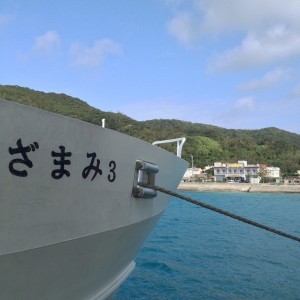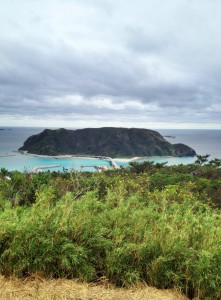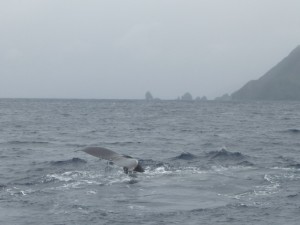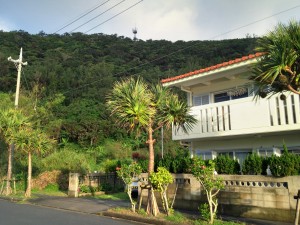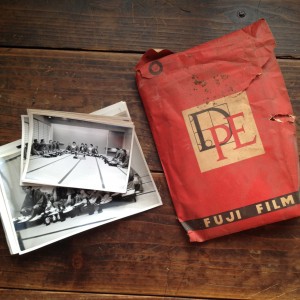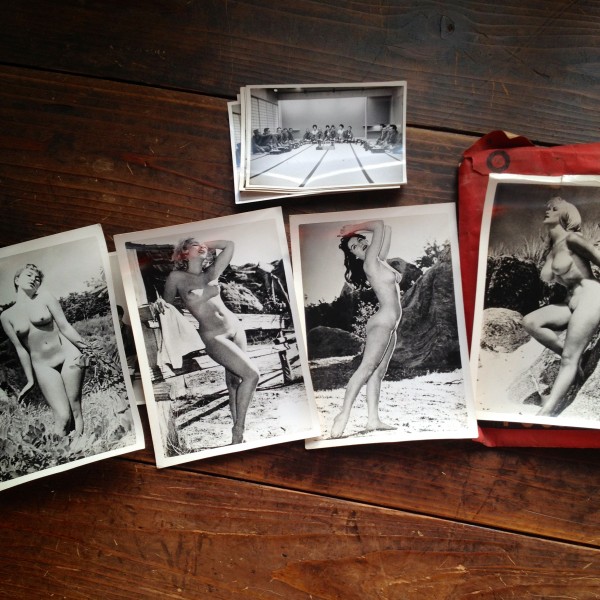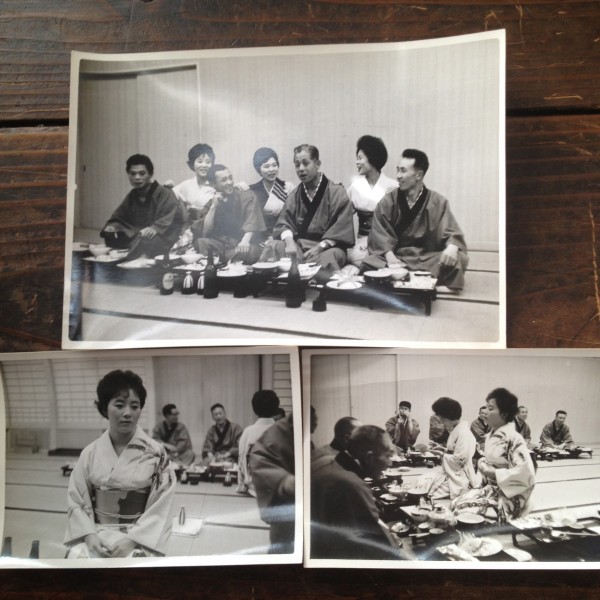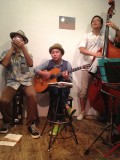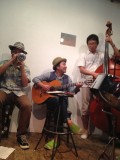Another year, another TaicoClub. Still as awesome as ever (in fact, quite likely the best mid-size music fest in Japan these days).
This year too, you can find a much more adequate write-up of the event by James on the TimeOut page. I’ll pitch in with my own trainspotter rant nonetheless (focussing on the music and leaving the personal antics and class A felonies tastefully out of the scope of this post).
Shortly after pitching our tent, we spent our first couple hours regrouping and chilling to the increasingly awesome mix of beats of one Kubota Takeshi (first time I saw him): liberal doses of latin beats (some Cumbia here, some Salsa there), eventually turning even more eclectic (transitioning from some unknown vintage latin beats to the Dropkick Murphys onto the Négresses Vertes. No kidding).
Unfortunately, the disco-nap that came next made us miss a large part of Colin Stetson‘s indescribably awesome performance. Possibly some of the most moving 20 minutes of non-stop sax vibrato I have ever heard.
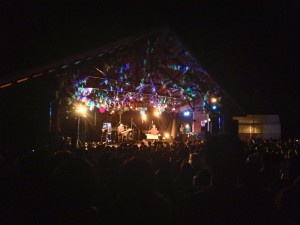 Next was clammbon, which I assume was formed by locking a hundred Japanese indie jazz-folk artists in a pitch-dark basement with a bunch of rabid ferrets and selecting the three last survivors still wearing a smile while keeping their quirky jazzy singing at whisper level the whole time. I mean it in a good way.
Next was clammbon, which I assume was formed by locking a hundred Japanese indie jazz-folk artists in a pitch-dark basement with a bunch of rabid ferrets and selecting the three last survivors still wearing a smile while keeping their quirky jazzy singing at whisper level the whole time. I mean it in a good way.
Diamond Version, on the other hand, was closer to what the non-surviving members of such a selection process might have sounded like, mid-mauling and attempting to defend themselves with a broken neon light (at least those last 10 minutes of their show we managed to catch).
Tycho was very beautiful. And also a bit soporific for a 10pm show (but that’s definitely a standard feature of TaicoClub programming). Meanwhile, Travis Stewart was performing at his first of many appearances during the night: first solo, as Machinedrum (seen last year), a couple hours later as a half of JETS (which I hear was awesome, in an old-school rave kinda way, and am very bummed on missing for sleep-related reasons) and finally, I can only presume, as Ricardo Villalobos, wearing a very convincing rubber mask (which would explain the intense sweating). He was last seen regulating traffic at the festival’s exit gate.
More than the fact that TaicoClub booked Japan’s most commercial techno act of the 90s (contrast with the rest of the line-up), what surprised me most about 電気グルーヴ was how absolutely all friends and acquaintances were openly keen on checking them out (considering how much scorn is usually heaped upon them by the more dedicated dance heads, let alone indie electronic fans). The show certainly delivered in cheesiness and (much welcome) easily-danceable beats. Pierre Taki, in his usual Mardi Gras top hat, pacing the stage and emceeing, while Takkyu Ishino manned the machines. Let’s not kid ourselves: for all the cheap beats and past-freshness singing, it was tough not to get a few goosebumps and launch into some maniacal dancing when the first turbocharged beats of Reaktion started filling the place (and somewhere in the back of my mind, the annoying music geek was wondering if the titular German-accented sample might have been lifted from Kraftwerk‘s Tour de France album, by any chance1Not, according to a very cursory google search.).
A short walk and a stage change later, the lyrics had gone from infantile to post-adolescent, with Of Montreal‘s brand of hormonal pop rock. A good energetic set, even though the band somehow mistook the Japanese alpine hippy setting of Taicoclub’s upper stage with Glastonbury, mid-90s-brit-pop era. The former probably not the best place for witty banter (in English) or for crowd surfing.
 Would have loved to go listen to Magda up close, but had to do with the soothing hardcore techno bass at a distance, from the comfort of our tent, getting the rest we needed to restart fresh and early in the morning. Not quite early enough to catch more than the closing notes of XXYYXX, but still too early to miss Ricardo entirely.
Would have loved to go listen to Magda up close, but had to do with the soothing hardcore techno bass at a distance, from the comfort of our tent, getting the rest we needed to restart fresh and early in the morning. Not quite early enough to catch more than the closing notes of XXYYXX, but still too early to miss Ricardo entirely.
Like every year, Ricardo Villalobos prompted much anticipation among Taicoclub regulars eager to know 1) how many more people had been added to his entourage since the previous year and 2) how much colombian dust had found its way into his system by the time he’d start his set. The unsurprising answer to both being: a fucking lot indeed.
With about half-a-dozen hangers-on loitering in the back of the admittedly vast and empty stage, up from a consistent 2-3 last year, there is a serious risk that next year will see more people behind than in front of the DJ. My best guess is that if you happen to be anywhere within close distance of Ricardo on the night he leaves for Japan, you get to share his business class seat ticket and sit on his laps. That or each of these people has a crucial role in the logistics of his performance (poodle trainer, line tester…).
Also much like last year, his set was at best mediocre (and barely mixed), with a few rare touches of brilliance: yes, it is 2013 and I danced to some vague progressive remix of KLF‘s What Time is Love2FUCK me, this song is 25 year old. Twenty five years. This song is not only of legal drinking age, but it has two kids and lives in the suburbs.. That aside, Ricardo would occasionally dive and disappear behind the decks table, apparently looking for something and unaware that his record bags were sitting on the table behind him. This was obviously making him quite cross, because he would reappear each time a little more tense at the jaw and a lot sweatier at the brows.
I’m told he came back as the “surprise guest” (schedule read “???”) for the last slot on that stage an hour later. That man works way too much, if you ask me.
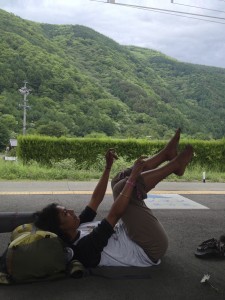 Other Taicoclub alumni Nick the Record closed the weekend in perfect fashion. I wish I could remember more specifics of his (very eclectic) set, other than it was awesome, funky and full of love, but sleep deprivation (among other things) claimed these last few hours and clarity is retrospectively lacking.
Other Taicoclub alumni Nick the Record closed the weekend in perfect fashion. I wish I could remember more specifics of his (very eclectic) set, other than it was awesome, funky and full of love, but sleep deprivation (among other things) claimed these last few hours and clarity is retrospectively lacking.
A few hours of train and train stations later, everybody was back on their respective side of the Kan (sai and tō) and a much longed for shower was had. That should conclude this year’s outdoor festival season: no Fuji Rock and most definitely no Summer Sonic here (hmn, maybe Nagisa?). Next camping will be at the beach and under the stars of Okinawa. Feel free to come and bring your boombox.

